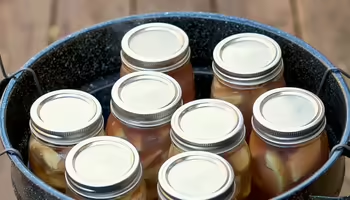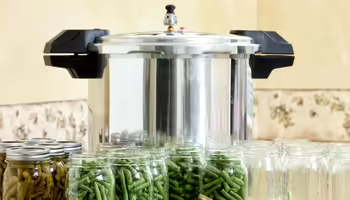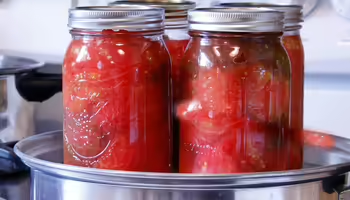Canning is Science.
Canning has changed over the generations. Today, all safe food preservation begins with using tested recipes and properly working equipment. Recipes passed down over the years can still remain special but should not be used for canning unless backed by scientific testing. The modern technology and testing equipment available to us now means there is no need to guess whether a recipe is safe or not. It means that we can preserve delicious food with confidence, knowing that we are keeping ourselves, our families, and our friends safe.
Extend the season for fresh produce.
Headspace
Unfilled space above the food in a sealed container and below the lid is called headspace and is needed to allow for the expansion of food while processing. The amount of headspace depends on the type of food being processed. Starchy foods tend to expand and swell when heated.
| Product | Headspace |
|---|---|
| Jams and Jellies | ¼ inch |
| Fruits and Tomato Based Products | ½ inch |
| Foods Processed in Pressure Canner | 1 to 1-¼ inch |
Food Acidity
A food’s acidity level determines which canning method can be used safely to preserve it. High-acid foods with a pH value of 4.6 or less can be processed safely in a water bath canner. Low-acid foods with a pH value higher than 4.6 require higher temperatures produced in a properly weighted pressure canner to be safely processed. Tomato products are borderline acidic and require additional acidification before processing to ensure safety.
Types of Added Acid
- Bottled lemon juice or bottled lime juice.
- Commercial brand citric acid.
- Vitamin C tablets.
- Ascorbic acid crystals.
- 5% acidity vinegar.
Adding Acid to Tomato-Based Products
Whether using a boiling-water bath or pressure canner for processing, all tomato products must have acid added. Most fruits can be processed using a boiling water bath because they are naturally high in acid. Tomato products, pickled foods, and figs must have acid added to them because they are not acidic enough on their own to prevent spoilage.
| Form of Acid | Amount per Pint | Amount per Quart |
|---|---|---|
| Bottled lemon juice | 1 Tablespoon | 2 Tablespoons |
| Citric acid | ¼ teaspoon | ½ teaspoon |
| Vinegar | 2 Tablespoons | 4 Tablespoons |
Adjustments
Never alter the amount of acid called for in a tested recipe.
- It is safe to substitute bottled lime or bottled lemon juice for a tested recipe that calls for 5% vinegar.
- Do not use fresh lemon juice or fresh lime juice as acidity levels can vary.
- Do not use key lime juice in any form (bottled or fresh); key limes have different acidity than regular limes.
- Do not substitute 5% vinegar if a tested recipe calls for bottled lemon or bottled lime juice.
Low-Acid Foods: Pressure Canner
The only safe way to can low-acid foods (pH over 4.6) is by using a pressure canner, which can reach the high temperature of 240 F. needed to destroy spores of the bacteria C. botulinum.
*Tomatoes may be pressure-canned or canned in a boiling-water bath canner but always with added acid. Follow the directions of the tested recipe.
High-Acid Foods: Boiling Water Bath Canner
High-acid foods (pH 4.6 or lower) can be canned safely using a water bath canner. Some foods have naturally high acidity, and others may require additional acidification to ensure safety.
*Tomatoes may be pressure-canned or canned in a boiling-water bath canner but always with added acid. Follow the directions of the tested recipe.
Low-Acid Foods Must be Pressure-Canned
Clostridium botulinum is a bacteria commonly found in soil and exists either as vegetative cells or as spores. These spores can be found on many fresh food surfaces. C. botulinum spores are harmless on fresh foods but can become deadly when improperly canned, leading to botulism.
During canning, air is vented out of the jar and a vacuum seal is formed. This process creates an anaerobic environment, which is the ideal growing condition for C. botulinum spores to grow. These spores produce vegetative cells, which then multiply rapidly and may produce a deadly toxin in a matter of days. Once toxins are present, they cannot be destroyed.
The only way to destroy C. botulinum and safely process low-acid foods is to use a pressure canner that will reach a temperature of 240 F.
It was once thought the longer you cooked canned goods, the safer the food. However, advances in science have proven this not to be true. C. botulinum is a tough germ that wants to stick around; no matter how long you process low-acid in a water bath canner, the temperature will never get high enough to destroy C. botulinum. Low-acid foods must be heated to a temperature of 240 °F and held there for a specified amount of time. The amount of processing time depends on the type of food and recipe being used. The combination of that high temperature and prolonged processing time destroys the bacteria and toxic bacterial spores produced by C. botulinum.
Approved Canning Methods

Boiling-Water Bath Canner
Use a boiling-water bath canner to can acidic foods with a pH value of 4.6 or less. Some other foods may be canned safely with this method but require acidification to reach the appropriate pH level.

Pressure Canner
Low-acid foods with a pH greater than 4.6 must be canned in a pressure canner, which can reach the temperature of 240 F required to destroy bacterial spores created by C. botulinum. Examples of low-acid foods include beans, most vegetables, meat, poultry, fish, soups, and broths.

Steam Canner
Steam canning is a safe alternative to boiling water bath canning for preserving many high-acid foods and is suitable for processing quarter-pint, half-pint, pint, or quart jars.